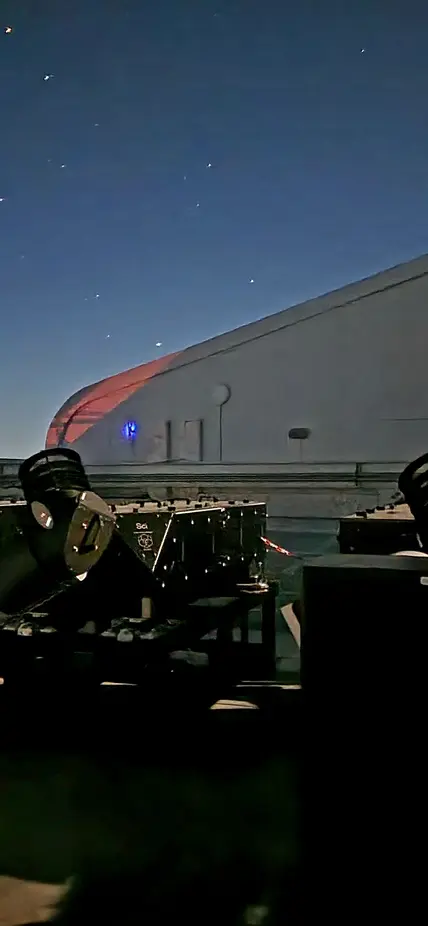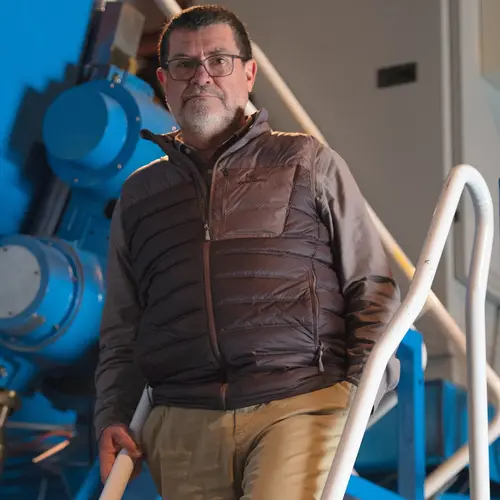An ambitious new suite of telescopes at Carnegie’s Las Campanas Observatory will create a spectroscopic map of our Milky Way galaxy and other nearby galaxies, enabling a new understanding of how they form and evolve.
Part of the Sloan Digital Sky Survey’s fifth generation, this new facility saw first light in August and is currently set to begin survey operations. Called the Local Volume Mapper, it will enhance our understanding of galaxy formation and evolution by probing the interactions between the stars that make up galaxies and the interstellar gas and dust that is dispersed between them.
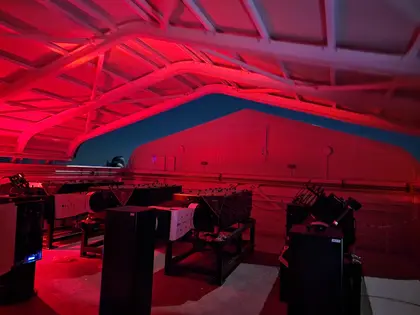
Unlike other surveys, which focus on individual objects, the Local Volume Mapper will allow SDSS to understand the cosmic ecosystem surrounding the Milky Way, its companions the Magellanic Clouds, and other local dwarf galaxies.
“I approach the LVM through the lens of our theoretical understanding of galaxy and star formation—the physical conditions of plasma as it goes through different cosmic cycles,” explained SDSS-V Director Juna Kollmeier, the Founding Director of the Carnegie Theoretical Astrophysics Center and current director of the Canadian Institute for Theoretical Astrophysics. “For decades, we have been doing calculations that zoom-in on these processes, but what was missing was the empirical benchmark. The LVM attempts to provide this reality check: observational targets against which our understanding can be challenged and deepened.”
LVM is one of three mapper’s that comprise the survey’s fifth generation. The Milky Way Mapper will reveal the physics of stars in our galaxy, the diverse architectures of its star and planetary systems, and the chemical enrichment of our galaxy since the early universe. The Black Hole Mapper will measure masses and growth over cosmic time of the supermassive black holes that reside in the hearts of galaxies as well as the smaller black holes left behind when stars die.
The other two mappers operate out of both Apache Point Observatory in New Mexico, home of the survey’s original 2.5-meter telescope, and Carnegie’s Las Campanas Observatory in Chile, where it uses the 2.5-meter du Pont telescope. However, LVM required the design, engineering, and erection of an entirely new facility in Chile.
The team that brought the LVM instrument to fruition was an international collaboration including scientists and engineers from Germany, Australia, Korea, and the United States. But Carnegie played a leading role in developing the vision and overseeing how all the component parts came together to create a brand-new way of studying our cosmic neighborhood.
“It was a huge endeavor for us and required developing a whole new area of expertise, much of it in the middle of a global pandemic,” said SDSS-V Project Manager Solange Ramirez, who works at the Carnegie Observatories. “Every generation of SDSS builds off the previous one, pushing discovery to the next level. To create LVM, we started with the science case and then had to design instruments capable of answering the questions we wanted to pursue—a process that involved a lot of debates and intense discussions.”
In order to tackle the research areas that Kollmeier and the SDSS-V team wanted LVM to advance, a new approach was needed.
“People always talk about big telescopes, but for our purposes small, fast, and extremely powerful was the right fit for creating the kind of maps that will enable us to understand the local galactic environment,” Ramirez added.
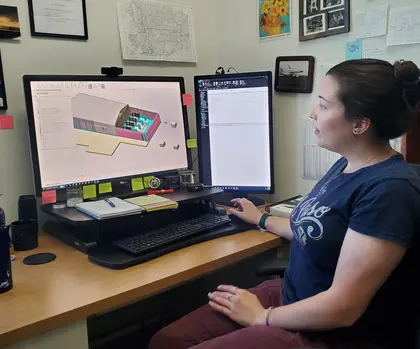
The facility consists of four custom-built telescopes which will capture visible light from the night sky with unprecedented speed and transport it via a bundle of 2,000 optical fibers, each the diameter of a human hair, to a suite of three spectrographs where it will be separated and analyzed.
“LVM takes advantage of a very basic, but very counterintuitive idea in physics, which is that the diameter of the lens is not what matters, rather the fstop—or opening of the aperture—is what matters for us,” said Carnegie Staff Scientist Nick Konidaris, who is the instrument lead on the project. “In many ways it is as powerful as an instrument on a vastly larger telescope—such as those being designed for the Giant Magellan Telescope, which is under construction at Las Campanas.”
To ensure that all of this precision engineering works as it should, LVM required the design and construction of a highly specialized facility that keeps each aspect of its work separated and protected from heat or motion.
“We had to build an incredibly detailed virtual recreation of every aspect of LVM and figure out where everything went and how it was all connected,” explained Carnegie Instrumentation Engineer Julia Brady, who coincidentally started her work on SDSS as an undergrad building instrument boxes for LVM at The Ohio State University, which she was then surprised to see at the Carnegie Observatories machine shop when she interviewed for her current position.
Shop Foreman Vince Kowal noted that due to the highly international nature of the LVM collaboration, the Carnegie team was involved not only with building aspects of the final construction—much of which was undertaken during the height of the covid-19 lockdown, requiring one-at-a-time access to the campus—but also with fabricating objects that were used for calibrating or testing aspects of LVM’s components.
And once all of the various parts were engineered, they had to be brought down to Las Campanas where the vision was made into a reality.
“It was a huge logistical undertaking,” said SDSS-V Lead Systems Engineer Stefanie Wachter, who works at the Observatories and ensured this complex system came together properly. “Carnegie is an awesome place where everyone just jumps in and helps. I had so much support from the team here and the staff at Las Campanas.”
Representatives from all of the international LVM teams came together in Chile in February 2023 to erect the structure and install of the telescopes, spectrographs, and other pieces of necessary equipment to keep them fixed in place and at the right temperature.
Now that this incredible new facility is up and running, SDSS-V researchers are eager to tap into its power and drive breakthrough science that will help us understand our galaxy.
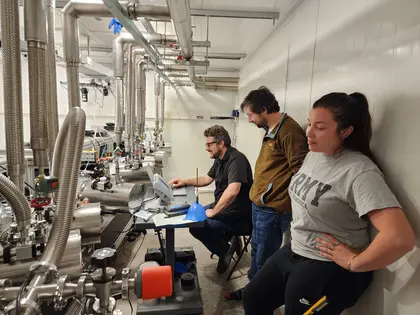
“LVM is going to give us thousands of times more coverage of the Milky Way than we’ve ever conceived of having before now,” Konidaris added. “In six or seven years we will have a new understanding of the Milky Way thanks to LVM’s incredible capabilities.”
The knowledge gleaned from the survey will inform how we think about galaxy formation and evolution beyond our own celestial back yard with implications for revealing the physics that shapes structure in the cosmos.
“The interstellar medium is a chaotic environment where it’s difficult to connect what is happening with the gas to any specific star and to build models that help us understand the Milky Way and its surroundings as part of an ecosystem,” said LVM survey scientist and Associate Director for Strategic Initiatives at Las Campanas Guillermo Blanc. “It’s like trying to look at river rapids and build a model of still water. The data from LVM will enable theorists to create more complex models that explain the interactions in play.”
The LVM is the latest development in Carnegie’s long-standing tradition of designing and building telescopes and instruments that enhance their abilities starting with Observatories founder George Ellery Hale—who built the world’s biggest telescopes twice over at Mount Wilson Observatory—through the twin Magellan Telescopes at Las Campanas, and looking ahead to the Giant Magellan Telescope’s completion at the end of the decade.
“While we are pushing the aperture frontier with Giant Magellan, we continue to advance the capabilities of our small telescope with exciting projects like SDSS-V and the LVM,” concluded Observatories Director John Mulchaey, who is also the Carnegie Institution’s Deputy for Science. “Astronomy and astrophysics is at the cusp of an era of major breakthroughs and Carnegie is proud to be at the center of multiple important initiatives that will drive new knowledge of the universe.”
Why Are You Excited About LVM?
Acknowledgements
Funding for SDSS-V has been provided by the Alfred P. Sloan Foundation, the Heising-Simons Foundation, the National Science Foundation, and the Participating Institutions. SDSS acknowledges support and resources from the Center for High-Performance Computing at the University of Utah.
